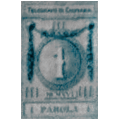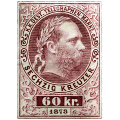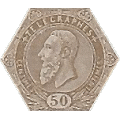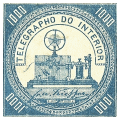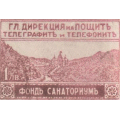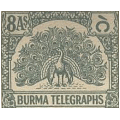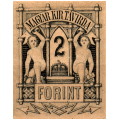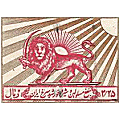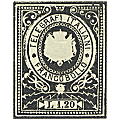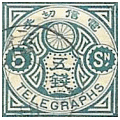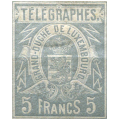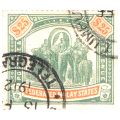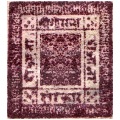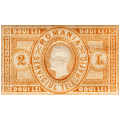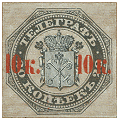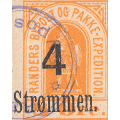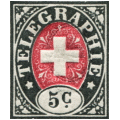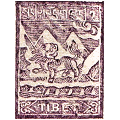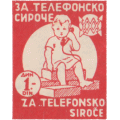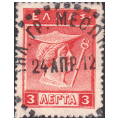| अनुवाद |
Übersetzen sie |
WORKING
|
Traduisez |
ترجم |
| перевести |
Traduca |
Traduzca |
翻译 |
|
Telegraph stamps of the World
Click here for a site-map. |
Select currency. Default = GBP (1.0)
|

I have updated to current prices together with currency selection.
CheckList Setup |
JAPAN.
Steve Hiscocks wrote in 1982:
At the time that the only set of Japanese Telegraph stamps was issued the Telegraph and Postal Authorities in Japan were separate. The stamps were issued on 7 May 1885 and first used on 1 July 1885. Their issue formally ended on 10 March 1888 and their use was prohibited after 28 February 1890. Around this time the Postal and Telegraph authorities were combined and postage stamps were then used on telegrams until 1949 when the organizations again separated and since when no stamps of any sort have been used.
While there were only ten basic stamps the picture is confused by a variety of papers (which, pending guidance on the subject I must omit for the present) and an amazing number of different perforations. Morley listed 16 different while I can separate out no less than 26 in my own collection. Morley's list is not compatible with my own since he did not measure to quarters and I have therefore relied on my own findings. It is a matter of some debate whether all of these should be regarded as separate. I have not been able to examine any complete sheets (even pairs are most uncommon) but I am told that the perforation can vary by as [much as] ¼ along a single line in the sheet. If one allows for this then four basic perforations emerge — 9±¼, 10, 11¼ and 13½ together with a scatter of other values which do not seem to fit into any of the major groups and are only known for one or two values in each case. Clearly, much more analysis is required on these to obtain a greater certainty of what differences are significant and, pending this, I have listed all those I have found and indicated prices according to observed scarcities for used copies. All unused copies are very rare.
Although perforated for separation, Japanese telegraph stamps were often apparently cut out with scissors resulting in many copies with clipped perforations. These naturally command lower prices. Used copies are normally cancelled with a neat round stamp in Japanese which, I am told, gives the name of the office at which they were used but not the date. It does not therefore seem possible to correlate perforation varieties with dates of use.
In the listing below only the prices for unused copies are listed against the descriptions while the prices for used copies are given, where particular combinations of value and perforation are known to exist, in the following table. Prices are based on current market values in Tokyo.
|
My note:
I have added sections for telegraphic usage of postage stamps and translation of dates and place names.
Telegraphy began in Japan with a government agency service between Tokyo and Yokohama in 1869.
Tōkyō, Yokohama, Ōsaka and Kobe were connected in 1870, opening for traffic in 1872. Nagasaki was added in 1873.
Submarine cables connected the principal islands and Taiwan, as well as Busan in Korea. The Great Northern Telegraph Company, connected Japan with Shanghai and Vladivostock.
Telegraph stamps were issued 7 May 1885 and first used on 1 July 1885. Their issue formally ended on 10 March 1888 and their use was prohibited after 28 February 1890.
Around this time the Postal and Telegraph authorities were combined, having initially been separate. Subsequent to this, postage stamps were used until 1949.
Currently Nippon Telegraph and Telephone Corporation (NTT) still delivers telegrams.
1885(1 July) Lithographed on thin white papers (various). No watermarks. Perfs. various between 8¼ and 13½ as tabulated below.
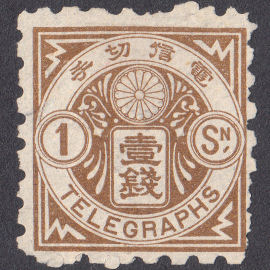 |
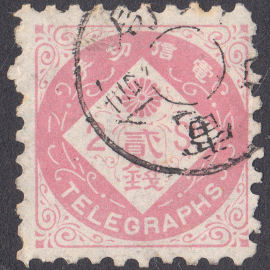 |
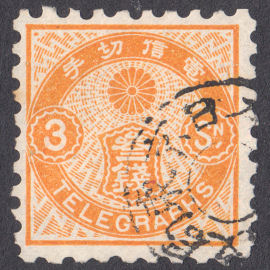 |
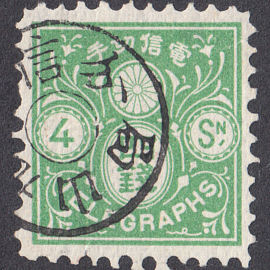 |
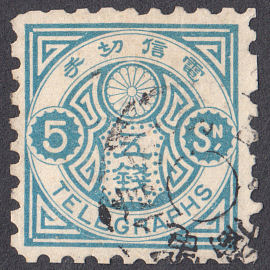 |
| Type 1. |
Type 2. |
Type 3. |
Type 4. |
Type 5. |
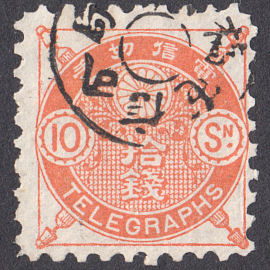 |
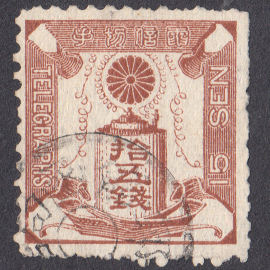 |
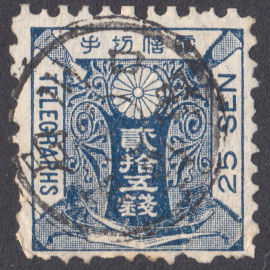 |
 |
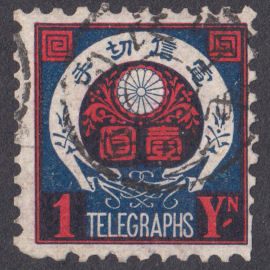 |
| Type 6. |
Type 7. |
Type 8. |
Type 9. |
Type 10. |
H1, H2, H4, H5, H8 and H10 - More can be seen at Stampboards.com
The Japanese writing on these read anti-clockwise on the stamps, but clockwise on the cancels. |
A big problem with this issue is the apparent large range of reported perforations.
This is probably due to uneven perforation coupled with a small stamp size.
| Hisc. |
Type |
Description |
Mint |
Used |
| H1 |
1 |
1 Sen yellowish brown |
32.00 |
16.00 + |
| H1a |
|
light yellow brown (perf. 9¼) |
50.00 |
16.00 |
| H2 |
2 |
2 Sen rose (slight shades) |
48.00 |
3.20 + |
| H3 |
3 |
3 Sen orange |
50.00 |
2.40 + |
| H3a |
|
yellow-orange |
50.00 |
2.40 + |
| H4 |
4 |
4 Sen light emerald green |
160.00 |
16.00 + |
| H5 |
5 |
5 Sen deep turquoise blue (shades) |
80.00 |
1.60 + |
| H6 |
6 |
10 Sen red-orange (shades) |
100.00 |
1.20 + |
| H6a |
|
yellow-orange (shades) |
100.00 |
1.20 + |
| H7 |
7 |
15 Sen red-brown |
120.00 |
1.20 + |
| H8 |
8 |
25 Sen deep blue |
160.00 |
1.20 + |
| H9 |
9 |
50 Sen reddish violet |
280.00 |
6.00 + |
| H9a |
|
pale reddish violet |
280.00 |
6.00 + |
| H10 |
10 |
1 Yen bright scarlet and deep blue |
800.00 |
80.00 + |
| H10a |
|
vermilion and deep blue (perf. 9¼) |
1100.00 |
120.00 |
Hiscocks added the following note:
Note. The prices for unused copies above are for those in perfect condition.
The vast majority have faults and would sell for much less. |
The table below is for used stamps with the indicated perforations.
Hiscocks' table originally gave specific values. This has been modified to give multiplication factors for the prices above.
| Perf. |
1 Sen |
2 Sen |
3 Sen |
4 Sen |
5 Sen |
10 Sen |
15 Sen |
25 Sen |
50 Sen |
1 Yen |
| 8¼ x 8½ |
|
1.33 |
|
|
|
|
|
|
|
|
| 8½ x 8½ |
|
|
|
1.67 |
|
1.67 |
1.67 |
|
|
|
| 8½ x 9 |
|
|
|
|
|
|
1.33 |
|
|
|
| 8¾ x 8½ |
|
1.33 |
|
|
|
1.67 |
1.67 |
|
|
|
| 8¾ x 8¾ |
|
|
1.00 |
1.67 |
|
1.67 |
1.33 |
1.33 |
1.00 |
|
| 8¾ x 9 |
1.00 |
|
|
|
|
|
|
1.33 |
|
|
| 9 x 8¾ |
|
|
1.33 |
|
|
1.67 |
|
|
|
|
| 9 x 9 |
|
|
1.33 |
1.33 |
1.50 |
1.33 |
1.33 |
1.00 |
1.00 |
|
| 9 x 9¼ |
|
|
|
|
2.00 |
1.67 |
|
1.67 |
|
|
| 9 x 9½ |
|
1.33 |
|
|
|
|
|
|
|
|
| 9¼ x 9 |
|
1.33 |
|
|
|
|
|
|
|
|
| 9¼ x 9¼ |
1.00 |
1.00 |
|
|
1.50 |
1.67 |
1.33 |
1.67 |
|
1.50 |
| 9¼ x 9½ |
|
1.33 |
|
|
|
|
1.67 |
|
|
|
| 9¼ x 9¾ |
|
|
|
|
|
|
1.67 |
|
|
|
| 9½ x 9½ |
|
|
1.33 |
|
1.50 |
|
1.67 |
|
|
|
| 9¾ x 9¾ |
|
1.33 |
|
|
2.00 |
|
|
|
|
|
| 9¾ x 10¼ |
|
|
|
|
|
1.67 |
|
|
|
|
| 10 x 9¾ |
|
|
1.33 |
|
|
|
|
|
|
|
| 10 x 10 |
|
1.33 |
1.33 |
|
1.00 |
1.33 |
1.67 |
1.33 |
1.33 |
|
| 10¼ x 10 |
|
|
|
|
|
1.67 |
|
|
|
|
| 11¼ x 11¼ |
1.25 |
1.33 |
1.00 |
1.00 |
1.00 |
1.00 |
1.67 |
1.67 |
|
1.00 |
| 11¼ x 11½ |
|
|
|
|
|
1.67 |
|
1.67 |
|
|
| 11½ x 11¼ |
1.25 |
|
|
|
|
|
|
1.67 |
|
|
| 11½ x 11½ |
|
|
|
|
|
1.33 |
|
1.67 |
|
|
| 13 x 13 |
|
|
|
|
|
1.67 |
|
|
|
|
| 13½ x 13½ |
|
|
|
|
|
1.33 |
1.00 |
1.33 |
|
|
Hiscocks added the following 6 notes:
Note 1. No doubt many more value/perforation combinations remain to be recorded
and I would welcome further information. |
Note 2. My copy of the 1 Yen, perf. 9¼ could be wrongly attributed in that it is clipped
on all but the top margin. I have assumed 9¼ x 9¼ but it could have been
9¼ x anything between 9 and 9¾.
The difference in shade of red is very marked. |
Note 3. I found considerable difficulty in finding a perforation guage accurate down to 8.
The best I have found is by 'Hawid' on glass. |
Note 4. The 10 Sen and 15 Sen (Nos. 6 & 7) are reported with the compound perforation
'11 x 10' — very rare used and unknown mint. The 15 Sen is also reported
with badly misplaced perforations. |
| Note 5. All multiples are very rare and especially so mint or, above the 10 Sen value, used. |
Note 6. Stamps on telegraph forms are occasionally found but are very rare and attract a
considerable premium. |
A 2012 Japanese Specialized Catalogue gives the following information:
The 'L' indicates large holes. Prices are in Yen / 100 i.e. approx $US.
| Perf. |
1 Sen |
2 Sen |
3 Sen |
4 Sen |
5 Sen |
10 Sen |
15 Sen |
25 Sen |
50 Sen |
1 Yen |
| 8½ x 10 |
35.00 |
8.00 |
8.00 |
60.00 |
8.00 |
2.00 |
2.00 |
2.00 |
30.00 |
200.00 |
| 11 L |
35.00 |
10.00 |
12.00 |
60.00 |
10.00 |
2.00 |
3.00 |
2.00 |
|
200.00 |
| 13 |
|
10.00 |
|
|
|
2.00 |
2.00 |
2.50 |
|
|
| 10 x 11 L |
100.00 |
|
|
|
|
|
50.00 |
50.00 |
100.00 |
|
| 11 L x 10 |
|
|
|
|
|
30.00 |
50.00 |
50.00 |
130.00 |
|
There is very little agreement with the list above. It does not even agree well with Hiscocks for basic perforations of 9±¼, 10, 11¼ and 13½.
In particular the 9±¼ range is absent.
Postal
From March 1888 to 1949, postage stamps were used for telegraphic purposes and can be identified by the cancels used.
As with the telegraph stamps, a wide range of perforations can be found.
From 1876 to 1894 the same basic 'Koban' set was in use, though with some colour changes and added values.
Here is a range of these stamps with telegraphic cancels (電信).
In the case of these, it reads clockwise with the additional part giving the place name (局 = station).
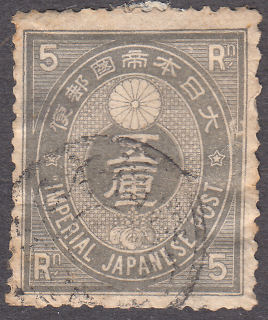 |
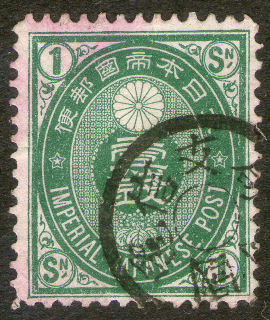 |
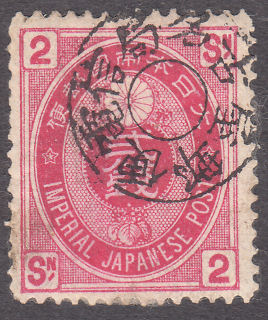 |
 |
| ½s, unknown location |
1s, unknown location |
2s, 名古屋 = Nagoya |
4s, perhaps 摂津 = Settsu (Osaka) |
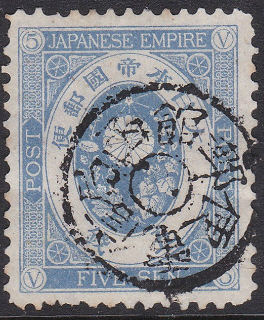 |
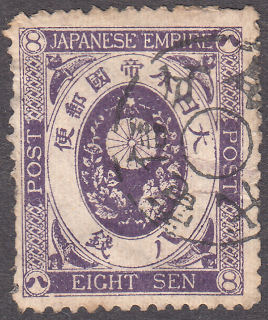 |
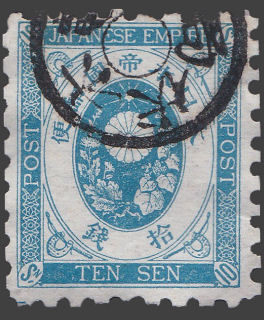 |
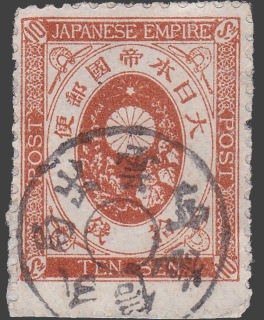 |
| 5s(1883), 函館 = Hakodate |
8s, unknown location |
10s 伏木 = Fushiki |
10s(1888), 出雲崎 = Izumozaki. |
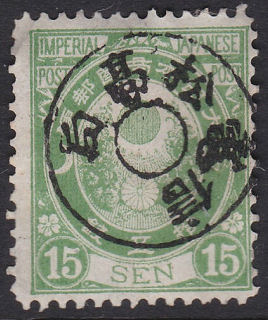 |
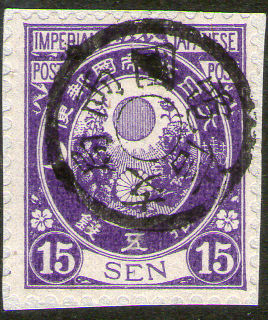 |
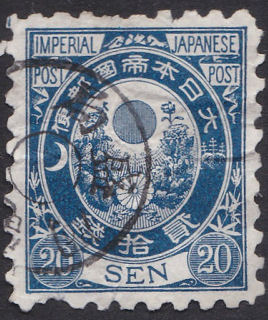 |
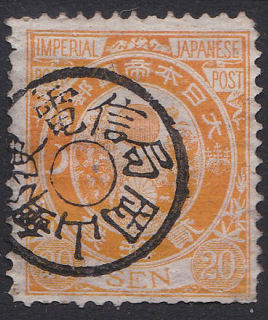 |
| 15s, 高松 = Takamatsu |
15s (1888), 両國 = Ryogoku, Tokyo |
20s, 盛岡 = Morioka |
20s (1888), 岡山 = Okayama |
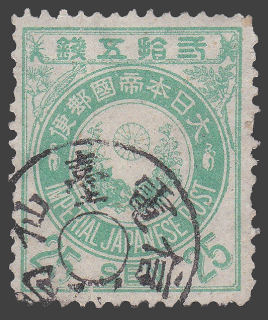 |
 |
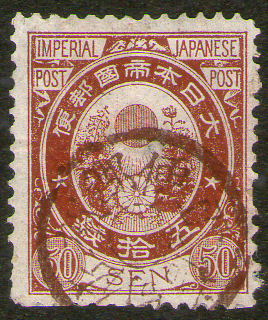 |
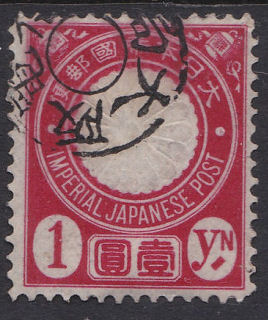 |
| 25s (1888), 仙臺 = Sendai |
50s(1879), 金澤 = Kanazawa |
50s(1888), Unknown location |
1Y(1888), 大坂 = Osaka |
The three with unknown location are mine. The rest are courtesy of gabychan2002 (click image for listing)
JSCA
In Japan there is a Japanese Stamp Specialized Catalogue (JSCA), Volume 1 of which covers 1871-1946 with over 500 pages.
Most copies seem to be in Japanese, but I understand there may be an English version.
The catalogue prices the Koban stamps with 23 styles of cancel including telegraphic (2011-12 catalogue).
The Scott catalogue (2007 general) list postally used prices and say they are
"... found with telegraph or telephone office cancellations. These sell at considerably lower prices than postally used copies."
For the sake of interest, I will tabulate the Koban stamps comparing Scott prices in US$ for postally used copies against
JSCA prices for telegraphic in Yen / 100 (it is currently ¥102 = US$1) and (the cheapest) non-telegraphic in the same units.
| Denom |
Colour |
Year |
Meiji Year |
Scott (US$) |
JSCA Post
(¥/100) |
JSCA Tel.
(¥/100) |
Shown above |
| 5r |
slate |
1876 |
9 |
10.00 |
30.00 |
x |
x |
| 5r |
grey-black |
1889 |
22 |
0.45 |
4.00 |
40.00 |
Yes |
| 1s |
black |
1876 |
9 |
4.25 |
10.00 |
u |
x |
| 1s |
maroon |
1879 |
12 |
1.25 |
4.00 |
400.00 |
x |
| 1s |
green |
1883 |
16 |
0.60 |
4.00 |
6.00 |
Yes |
| 2s |
brown olive |
1876 |
9 |
3.00 |
9.00 |
u |
x |
| 2s |
dark violet |
1879 |
12 |
2.00 |
5.00 |
400.00 |
x |
| 2s |
carmine-rose |
1883 |
16 |
0.25 |
2.00 |
5.00 |
Yes |
| 3s |
orange |
1879 |
12 |
24.00 |
60.00 |
250.00 |
x |
| 3s |
lilac rose |
1892 |
25 |
0.45 |
4.00 |
x |
x |
| 4s |
blue-green |
1876 |
9 |
4.00 |
8.00 |
8.00 |
Yes |
| 4s |
olive bistre |
1888 |
21 |
0.45 |
4.00 |
10.00 |
x |
| 5s |
brown |
1876 |
9 |
22.50 |
30.00 |
u |
x |
| 5s |
ultramarine |
1883 |
16 |
0.50 |
2.00 |
2.00 |
Yes |
| 6s |
orange |
1877 |
10 |
57.50 |
180.00 |
180.00 |
x |
| 8s |
violet brown |
1877 |
10 |
6.00 |
10.00 |
10.00 |
Yes |
| 8s |
blue lilac |
1888 |
21 |
1.60 |
6.00 |
50.00 |
x |
| 10s |
blue |
1877 |
10 |
2.50 |
6.00 |
5.00 |
Yes |
| 10s |
brown orange |
1888 |
21 |
0.45 |
4.00 |
3.00 |
Yes |
| 12s |
rose |
1877 |
10 |
150.00 |
380.00 |
350.00 |
x |
| 15s |
yellow green |
1877 |
10 |
2.50 |
40.00 |
5.00 |
Yes |
| 15s |
purple |
1888 |
21 |
0.50 |
2.00 |
2.00 |
Yes |
| 20s |
dark blue |
1877 |
10 |
12.00 |
40.00 |
30.00 |
Yes |
| 20s |
orange |
1888 |
21 |
1.50 |
6.00 |
6.00 |
Yes |
| 25s |
blue-green |
1888 |
21 |
1.50 |
6.00 |
6.00 |
Yes |
| 30s |
violet |
1877 |
10 |
110.00 |
220.00 |
220.00 |
x |
| 45s |
carmine |
1877 |
10 |
525.00 |
1300.00 |
1300.00 |
x |
| 50s |
carmine |
1879 |
12 |
12.50 |
40.00 |
35.00 |
Yes |
| 50s |
brown |
1888 |
21 |
3.25 |
12.00 |
20.00 |
Yes |
| 1y |
carmine |
1888 |
21 |
4.25 |
12.00 |
40.00 |
Yes |
Dates
The stamps above were used in the Meiji (明治) period that began with a change of emperor in 1867 and ended 30 July 1912,
when the Taishō period (大正) began (until 25/12/26).
For reference 年 = year, 月 = month and 日 = day (this is the same as Chinese) 明治30年6月26日 = June 26, 1897. Sometimes 明治 was omitted.,
The years were given with respect to the reign of the emperor so during this period, 1867 needs to be added to the year.
This table shows the numbering, though remember that sometimes the dates are right to left and sometimes the reverse.
| 一 | 二 | 三 | 四 | 五 | 六 | 七 | 八 | 九 | 十 | 十四 | 二十 | 廿 | 三十 | 丗 | 三十一 |
| 1 | 2 | 3 | 4 | 5 | 6 | 7 | 8 | 9 | 10 | 14 | 20 | 20 | 30 | 30 | 31 |
| Era |
from |
to |
range |
Add |
| Meiji |
1868 |
1911 |
1 to 44 |
1867 |
| Taisho |
1912 |
1925 |
1 to 14 |
1911 |
| Showa |
1926 |
1988 |
1 to 63 |
1925 |
| Heisei |
1989 |
2019 |
1 to 31 |
1988 |
| Reiwa |
2020 |
current |
1 to 2 |
2019 |
This is a list of Japanese place-names that I know.
It has been compiled from the eBay listings of gabychan2002.
 |
You can lengthen or shorten the table with the arrows. Rows can be highlighted by clicking on them. |
 |
The table can be sorted by clicking on the buttons at the top of the columns. Click again to reverse the order.
Later postal use.
This early series began to be replaced in 1899.
On this later 1906 pair (年九丗), the writing is right to left.
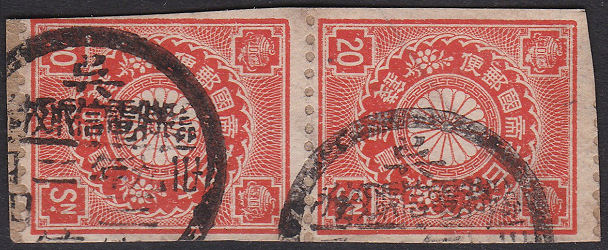
At the top is the place name (呉 = Kure).
Followed by 臨時電信取扱所 (right to left) which translates as temporary telegraph office.
Below that is the date which is rather hard to read on this.
Image courtesy of gabychan2002 (click image for listing)
This stamp seems to have been used for telephone purposes in 1906.
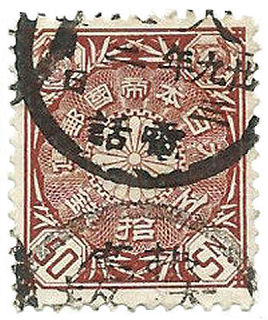
Googles' translator says 電話 = telephone. The Japanese script is reversed on this cancel, but looks very similar.
The date is 月 二 年 九 丗 / 日 三 which is (backwards for) 3rd February 1906 (39 + 1867).
The location, visible on the bottom strike, is hard to read, but I am told by gabychan2002 that it is
Settsu, Osaka 摂津 / 大坂. This written backwards gives 津 摂 / 坂 大.
Image courtesy of Mark (philatelistgb on eBay).
Anatomy of a Telegraph Cancel
The type below became fairly common later, but interpretation may not be obvious.
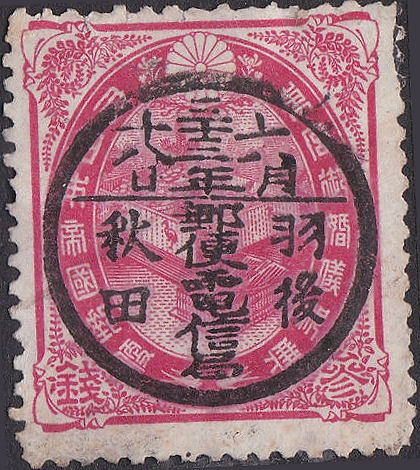
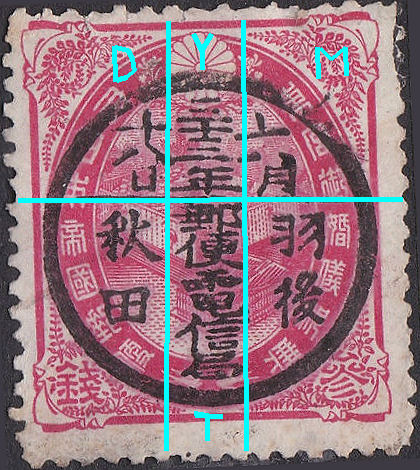
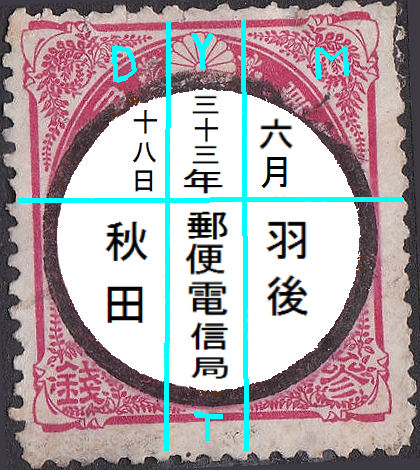
Image courtesy of gabychan2002 (larger than scale). I have divided it into sections.
At the bottom-centre marked 'T' is says '郵便電信局' meaning Posts and Telegraph Office.
To the right, followed by left of this it says '羽後 秋田' meaning Ugo Akita, the location.
Above is the date. The day(日) is 十八 or 18, the month(月) is 六 or 6, and the year(年) is 三十三 or 33 of the Meiji period, or 1900.
The stamp is to commemorate the Royal Wedding and was issued 1th of May 1900.
Notice that the characters tend to run into each other vertically.
Forgeries
One thing I came across worth mentioning, there appear to be quite a few forgeries about of early Japanese stamps,
including the set above (referred to as the Koban stamps), together with fake cancels.
Indeed some are marked sanko, mozo, or mihon meaning "reference", "imitation" or "specimen" respectively.
Thankfully, the forgers appear to have had little desire to forge telegraph stamps or cancels. However ...
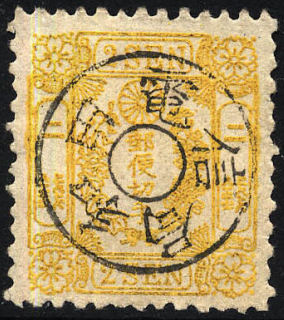
This one got me excited when I first saw it. It appears to be a telegraph cancel on the issue prior to the Kobans.
gabychan2002 however tells me that the cancel "says “WADA’ (和田) which is a very famous (notorious) company that used to make forgery stamps"
and goes on to say "Neither stamp nor the cancel are genuine".
Other things
These caught my eye because of the characters for telegraph on the cancel of the first.



Two similar items, 5 Sen and 1 Yen (in the middle). The left has a cancel with Tokyo(東京) written right to left at the top.
Underneath that it has what looks like something ending with 'Telegraph School'(電信学校), again right to left. Underneath that is a date, May 1897 perhaps.
Since writing the above, I came across meiji-portraits written in German, English and Japanese that shows (under May 1885) additional examples of these training stamps.
The author of the website, Bernd Lepach has kindly provided me with additional information.
There is more than one series of these, in fact two in this Koban style, but I think this is the earliest. On the right hand image I have divided it into sections for easy reference.
The black rectangle contains '郵便' meaning 'postal', blue has '實践' meaning 'practice' and the green has '切手' meaning 'stamp'. This is a practice stamp for training purposes.
Down the centre, there is a logo having 'T' and 'P' superimposed, perhaps for 'Posts and Telegraphs'.
Then is the value '壹 / 圓' meaning '1 Yen'. The other has '五 / 金芬' meaning '5 Sen'.
A problem sometimes is that the old forms for characters are no longer used.
It is likely that these are dummy stamps used for training purposes.
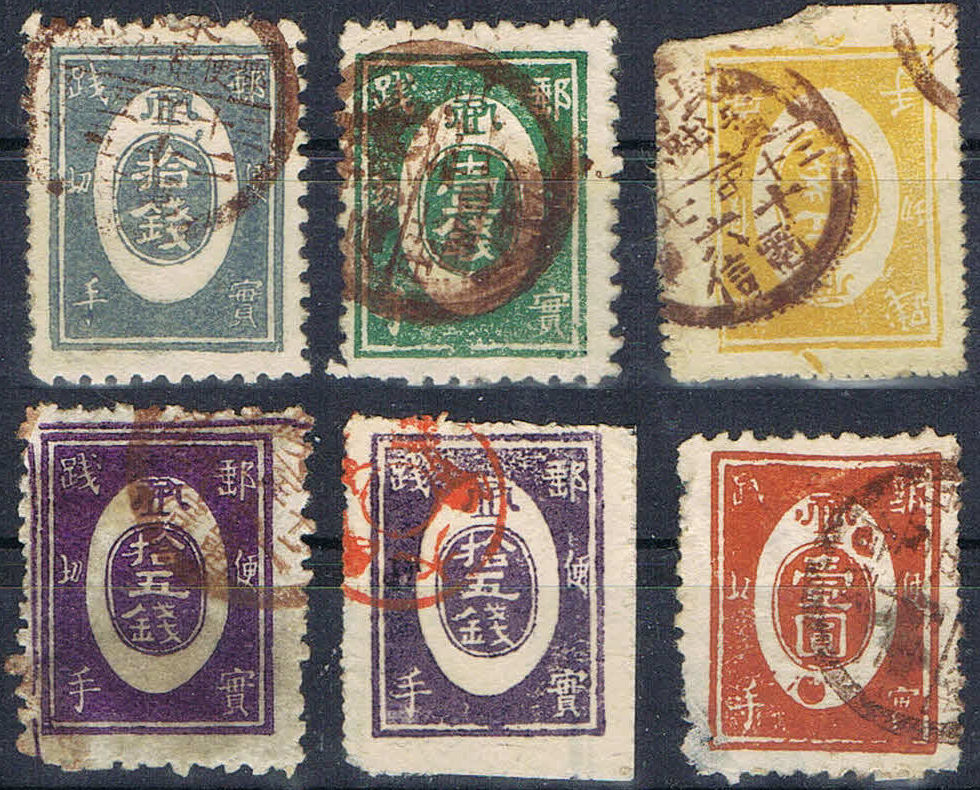
Here are some more examples courtesy Bernd Lepach. The yellow one is inverted to show the cancel.
The two purple (5 Sen) ones are inscribed '才台' above the value meaning 'only Taiwan'. The grey one is similar and I assume is 1 Sen.
The dates I can read are all in Meiji year 30 (年十三 reading right to left) meaning 1897. But I cannot read the locations.
Two more have recently come to light.


The left is marked 廿 / 五 / 金芬 for 25sen and the right is marked 五 / 才台 / 金芬 for 5 Taiwan sen.
Images courtesy of treasurings-jewelry, click image for listing.
For what it's worth:
This is labelled in English "The International Wireless Communication System of Japan".
Underneath, as close as I can render it, is "圖統系信通線無際國本日" in stylized old Japanese reading right to left
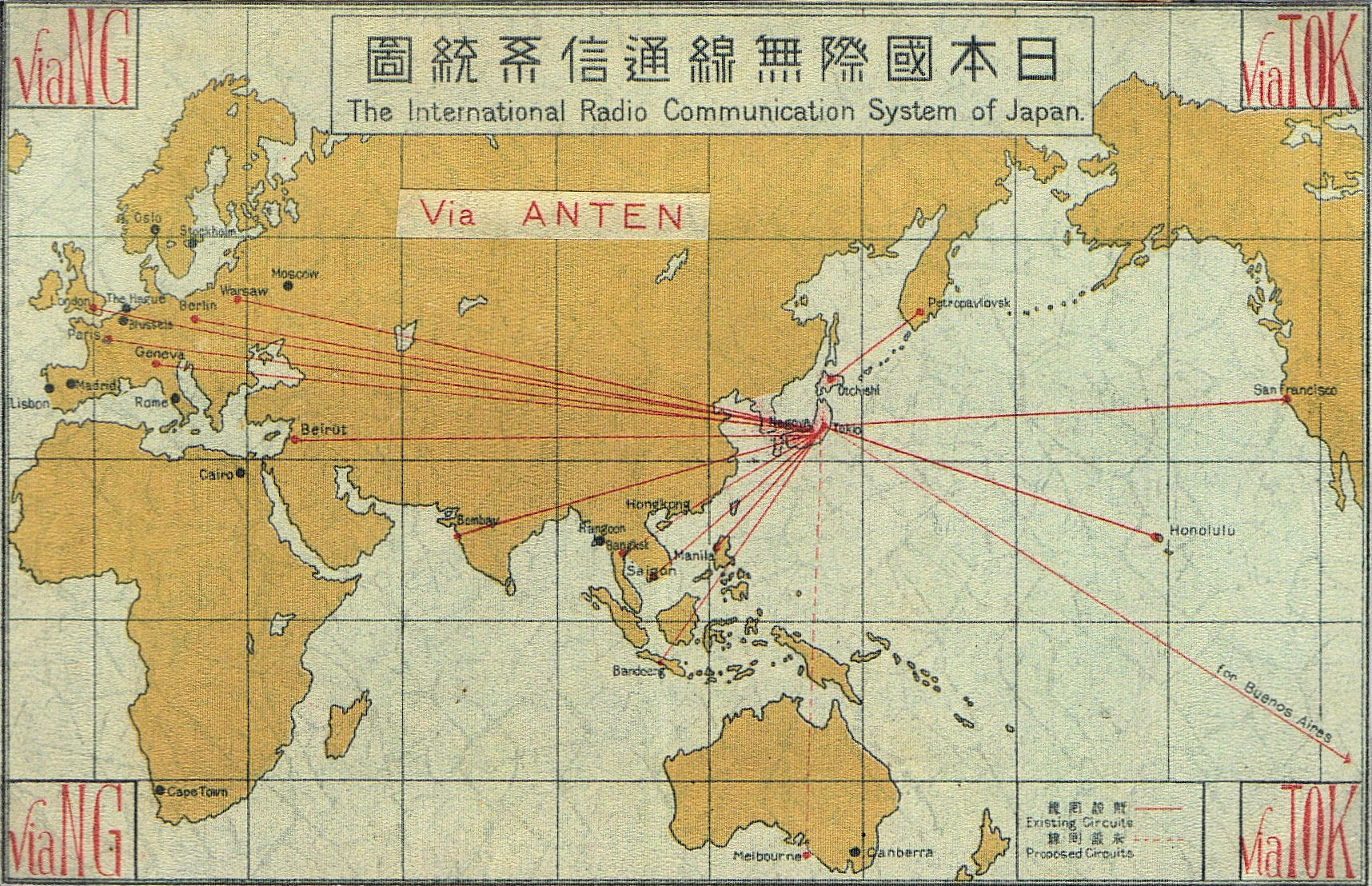
This says basically the same, but with 圖 on the end meaning "map". It dates from about 1929, showing the existing and proposed radio links. The corners have "viaNG" and "viaTOK" for options to use Nagasaki or Tokyo.
"Via ANTEN" I take to mean "Via Antenna". Image courtesy of Les Bottomley.
Telegraph Seals
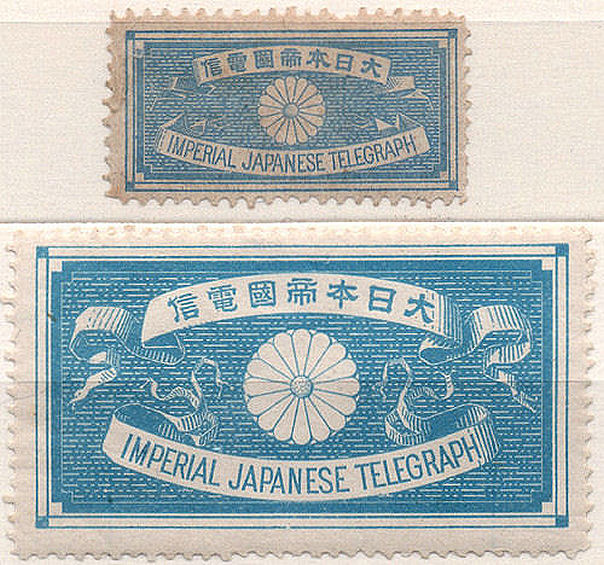
These are Hiscocks #2 (1889, Perf. 13, 28mm) and #3 (1890, Perf. 11½, 45mm).
 |
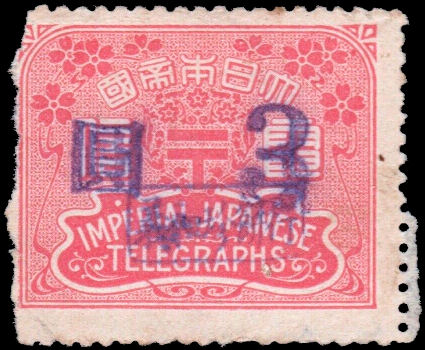 |
This is Hiscocks Japanese Telegraph seal #5 (1890, Perf. 11½, 30mm).
There is a larger one #6 (1911-28, Perf. 11½, 39mm). |
This seal #5 overprinted 3 Yen was stated to have been used in China.
The violet inscription appears to read 義和珍所行 (Yiwa Clinic ?) |
For use in Korea ?
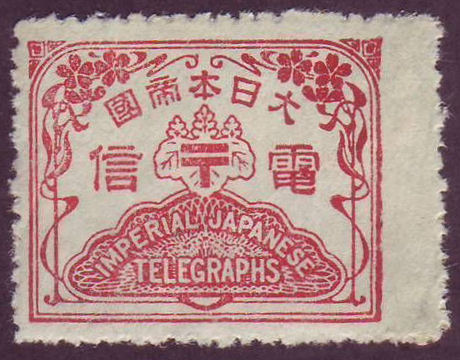
This is Hiscocks #11 (unknown date, Perf.11, 30mm) often described as "for use in Korea", but with nothing on it to suggest that.
The design is very similar to the item above, with something like 亍.
This is shown on the 1½s Japanese stamp of 1921 and is apparently the emblem of the telegraph service.
Image courtesy of Dick Keiser.
Steve Hiscocks made a start on cataloguing seals of the world in a book he published in 2007.
It was his hope to update it later, but unfortunately that was not to be.
His original book can be viewed at
Telegraph Seals: A World Catalogue. There are links from the pages to my updates.
Alternatively you can view the latest page for Japan.
Stationery
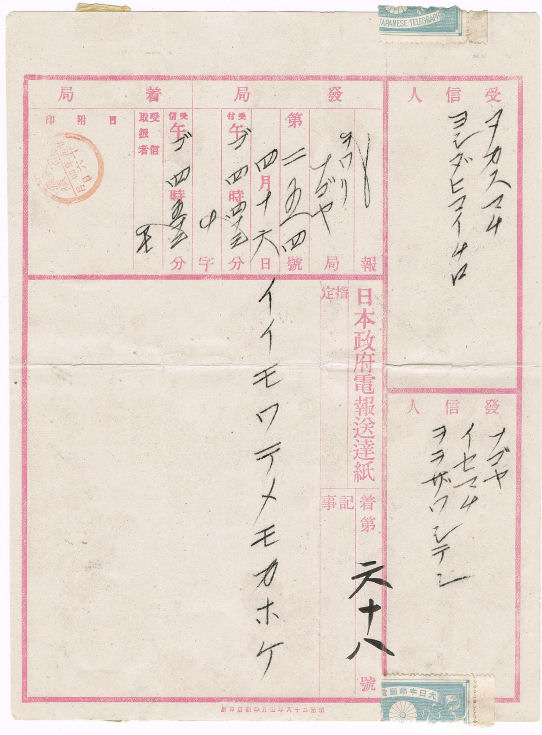
A form used in 1896 courtesy of Bernd Lepach
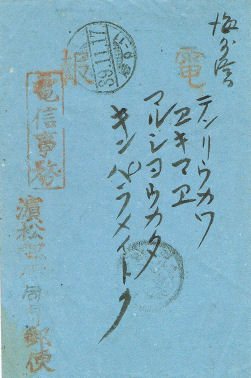
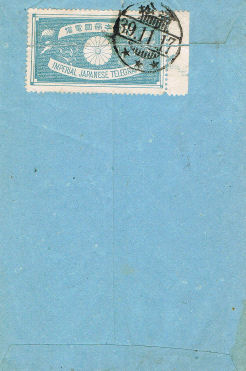
A 1906 envelope - front and rear courtesy of Bernd Lepach
The cancel on the seal was presumably to make it hard for a seal to be removed for access then replaced by another.
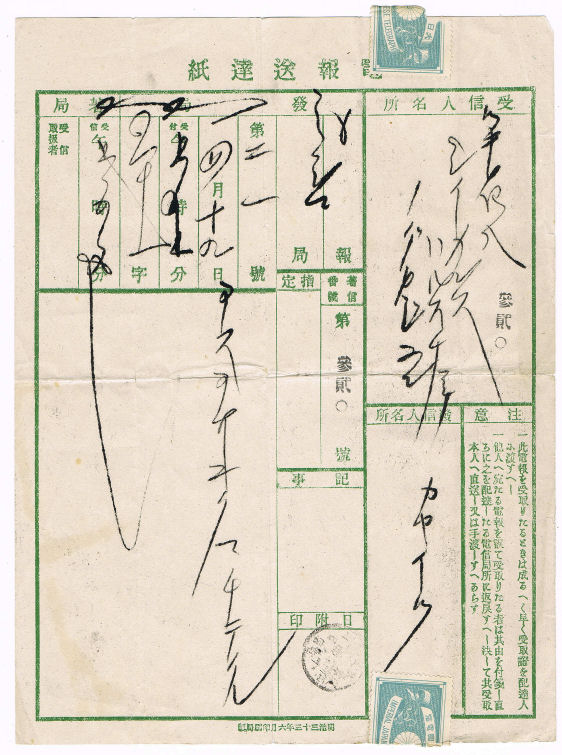
A form used in 1908 courtesy of Bernd Lepach
If anyone can provide scans to help with this, I am happy to give appropriate credit.
Comments, criticisms, information or suggestions are always welcome.

Please include the word 'Telegraphs' in the subject.
Last updated 15th. February 2024
©Copyright Steve Panting 2012/13/14/15/16/17/18/19/20/21/22/23/24 except where stated.
Permission is hereby granted to copy material for which the copyright is owned by myself, on condition that any data is not altered and this website is given credit.


